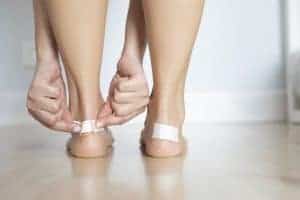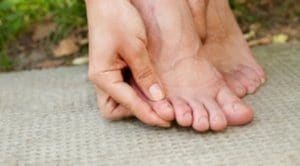Blister

Blisters are fluid-filled sacs that protrude from the topmost layer of skin. This can be a reaction to injury or infection. The purpose of a blister is to prevent the affected area from further harm.
Blisters typically develop in areas where the top layer of skin is most thick, as the strength of the skin secures the seal for the fluid. Common areas include the feet and hands.
Unfortunately, due to the level of nerves and blood vessels concealed within the foot, blisters there can be quite painful. Additionally the location of a blister on a foot can prove to be difficult to manage and treat. This can lead to further frustration and pain.
Here, we will examine treatment options available and the applications of each.
Causes and symptoms of Blisters

Typically, blisters are a reaction to friction on the skin damaging the undercarriage of top-layer skin, but can also be caused by a more serious injury or an infection. The common denominator in the occurrence of blisters lies in the damage to the blood vessels.
Common causes of blisters on the feet include the following:
Blisters from friction and pressure

The friction and pressure can be a combo attack from your shoe, sock, or rough surface grinding on a singular spot, which leads to inflammation and irritation. Redness, swelling and pain are expected.
There will likely be a red sore that develops before the actual blister, and at this stage it is imperative to avoid aggravating the affected area further, as it is possible that a blister may not develop from this sore. This can be easily corrected in the office with a simple bone procedure to correct the underlying hammertoe.
Shearing of the skin is where the skin tears apart due to the inflammation. The fluid that fills the area is intended to protect the delicate underlying tissue.
Blisters from Burning attempts to protect the bottom layers of skin from damage.
Blisters that arise from first- and second-degree burns can appear days after the initial burn, while more severe burns cause a reaction instantaneously.
Burn blisters are often masked behind the original burn, so they tend to go unnoticed by the afflicted. They heal as the burn heals naturally, and cannot be distinguished from the burn.
Blisters from Freezing
The body’s natural reaction to extreme cold can include the formation of blisters beneath the dying cells of the skin. Blisters are able to better hold in the body’s heat as the cold attempts to penetrate into the deeper layers of skin.
Frostbite burns will often begin to show signs of affect immediately, and like normal burn blisters, will be impossible to distinguish from the marks of the burns.
Contact dermatitis and Blisters
Contact dermatitis is a form of skin inflammation that can occur if the skin becomes exposed to an irritant. As the exposure continues to degenerate the skin, a blister can form. Allergens can also trigger a similar reaction with enough exposure. These kind of blisters can occur immediately or appear gradually after long term, low-dose exposure. Chemical burns can also cause blisters to appear.
Generally these types of blisters are caused by:
- insect bites and stings
- skin allergens
- chemicals in washing detergents
- chemicals in bodywashes
- chemical solvents or cleaners
- sulfates
- cobalt
- nickel
Blisters from Medical conditions
After the skin is weakened, blisters can form on the outer layer of skin. This can occur due to certain infections and disorders.
These common conditions and prescribed treatments influence blisters forming on the feet:
- chicken pox
- eczema, including dyshidrotic eczema, which can cause small, itchy blisters on the tips of the toes and soles of the feet
- autoimmune conditions, like pemphigus and bullous pemphigoid
- diabetic neuropathy or nerve damage that causes a lack of sensation or pain in the feet
- being overweight, as the increased weight puts pressure on the feet
- antibiotic treatment
- blood-thinning medications
Ruptured blood vessels
Damaged Blood vessels leak and form blood blisters under the skin. Typically this occurs when the skin is pinched or crushed.
Treatment of Blisters
A good way to protect your blister from further damage is to use over-the-counter blister bandages. Typically the best treatment for blisters is to let them be. With simple care, blisters will often heal on their own.
The presence of blisters is an important part of the body’s defense system, and it is unwise to disturb them. While blisters may pop naturally, it is best that you leave them alone so they can remain a barrier while your body heals the affected area.
Blisters act as a seal to keep out contagion and harmful elements in the environmental from entering the damaged space.
Once a blister appears, avoid placing additional pressure on it to preserve the seal. Once the seal breaks, then very gently wash around the blister with warm soap and water. Then cover it with a sterile, dry and breathable dressing. Gauze or a loose bandage works well in this endeavor.
In the event a blister forms due to a chemical or allergy burn, it is imperative that you remove yourself from the cause as soon as possible. Afterwards, wash the skin thoroughly.
Other treatments of a blister on your foot:
- gently applying an ice pack that has been wrapped in a towel.
- covering the affected area with an over-the-counter bandage.
- elevating your foot with a chair or pillow can reduce blood flow, limiting potential inflammation.
- drying the area aids healing.
- removing constrictive footwear or socks, as they may have been the cause.
- apply antibiotic ointments and creams to the blister and the surrounding area
- clean the area around of the blister with over-the-counter solutions such as hydrogen peroxide or apple cider vinegar to help reduce inflammation.
Allow the blister to open naturally. Then you should take a pair of sterilized tweezers to remove any remaining dead skin. Take care to avoid removing any healthy skin.
How do you properly clean and dress a blister?
Cleaning and dressing a blister can be pretty complicated especially if you are doing it for the first time, here are some steps to help you out:
- Wash Your Hands
Make sure you thoroughly wash and clean your hands before doing anything to the wound, as dirty or unclean hands can have bacteria and can lead to injection.
- Wash the Blister
Washing the blister area is also essential, make sure it’s also washed with clean water and soap. However, avoid chemicals like hydrogen peroxide and alcohol, as it can delay the healing which leads to risks if infection.
- Protect the Blister:
- Intact Blister: If your blister is intact, it’s best to keep it that way and avoid it from popping. Cover it with a clean and non-stick bandage or a blister-specific pad to prevent it from further friction.
- Burst Blister: If your blister has already burst, do not remove the skin covering it as it protects the underlying tissues. Just make sure to apply an antibiotic ointment to prevent infection.
- Secure the Dressing:
Use a medical tape or adhesive bandage to keep the dressing on the place, make sure it’s secure but not too tight.
- Change Dressings Everyday
Change the dressing everyday, or at least whenever it’s wet or dirty, this way you can easily avoid the risk of infection and promote a healthy healing.
Can blisters leave permanent scars?
Usually, Blisters do not leave permanent scars especially if they are cared properly, however if one is popped prematurely, it can lead to infection and delay healing, which increases the risks of scarring.
You must make sure you keep the blister clean, protected and is allowed to heal naturally, this way it will heal much faster and leave to scars at all.
Home Remedies For Blisters!
In some cases if your blisters aren’t too serious you can treat them with home remedies!
They are really effective and can even save your visit at hospital, so why not give them a try.
However, if they don’t work for you then you should try to talk to your doctor about it, they will surely help you.
For those looking forward to use home remedies, here are some:
1. Coconut Oil
If you didn’t know about this before then keep this thing in your mind that coconut oil is really useful while treating problems like blisters.
Its because coconut has lauric acid, it’s a type of acid that will hydrate your blisters and decrease the amount of inflammation and discomfort.
Furthermore, coconut oil can help you heal faster by repairing your tissues.
If you want to apply coconut oil to your blister then you can use a cotton ball for it.
Its safe to apply the oil directly to your wound so you don’t need to worry about any side effects.
2. Aloe Vera
Everyone knows about aloe vera and its magical effects on our body. It can help you improve your skin and make it healthier.
But there’s another use of this aloe vera! It will help you get rid of the annoying blisters.
Aloe vera has many anti-fungal and anti-bacterial properties that will help you get rid of infections and germs and this includes blisters too.
Just like coconut oil you can apply aloe vera gel on your blister to help you get rid of them.
But these aren’t the end of miracles of aloe vera, it can help you heal faster and reduce inflammation and discomfort as well.
If you don’t have aloe vera at your home then don’t worry you can purchase it online or get aloe gel from general stores.

